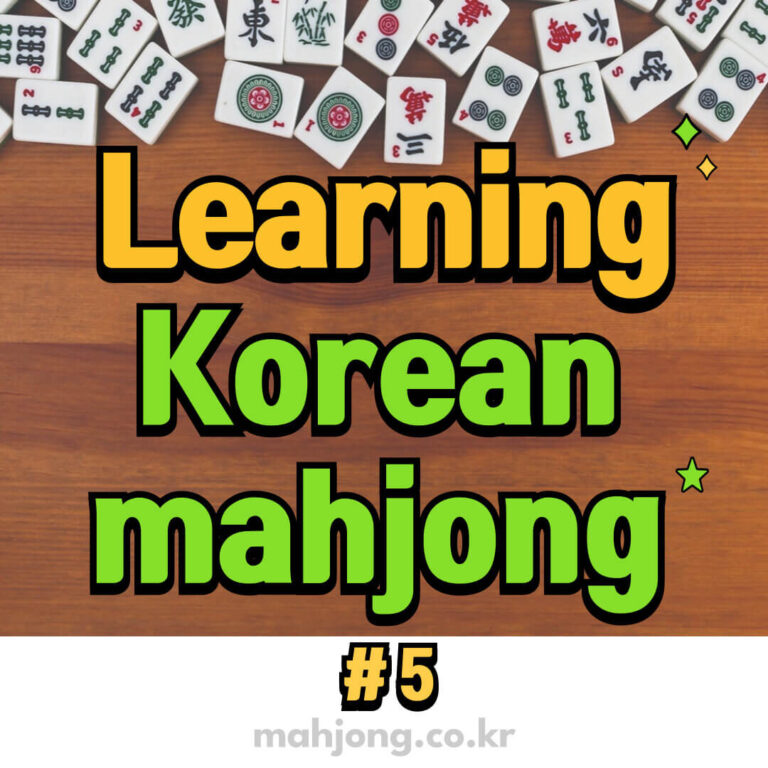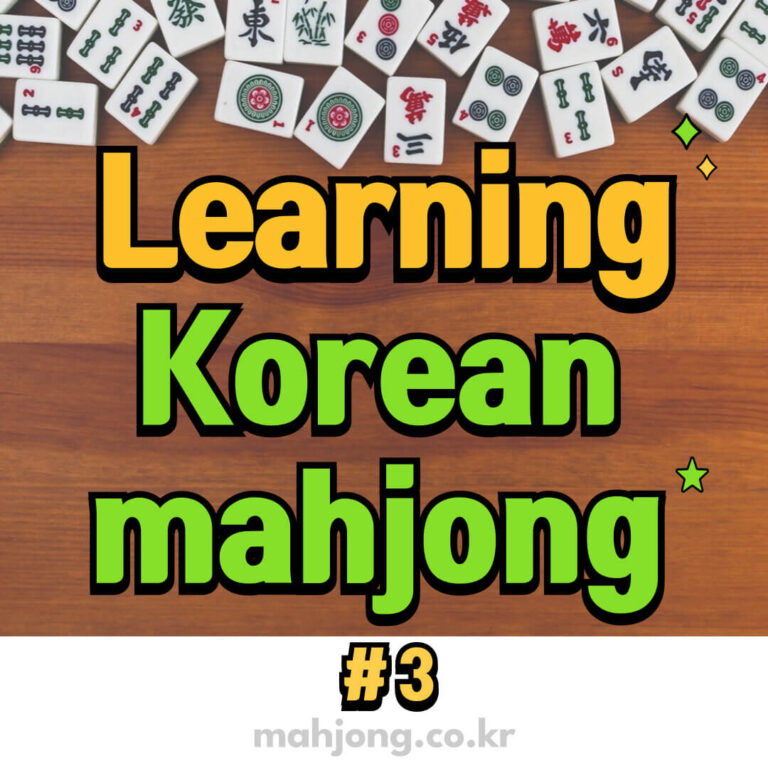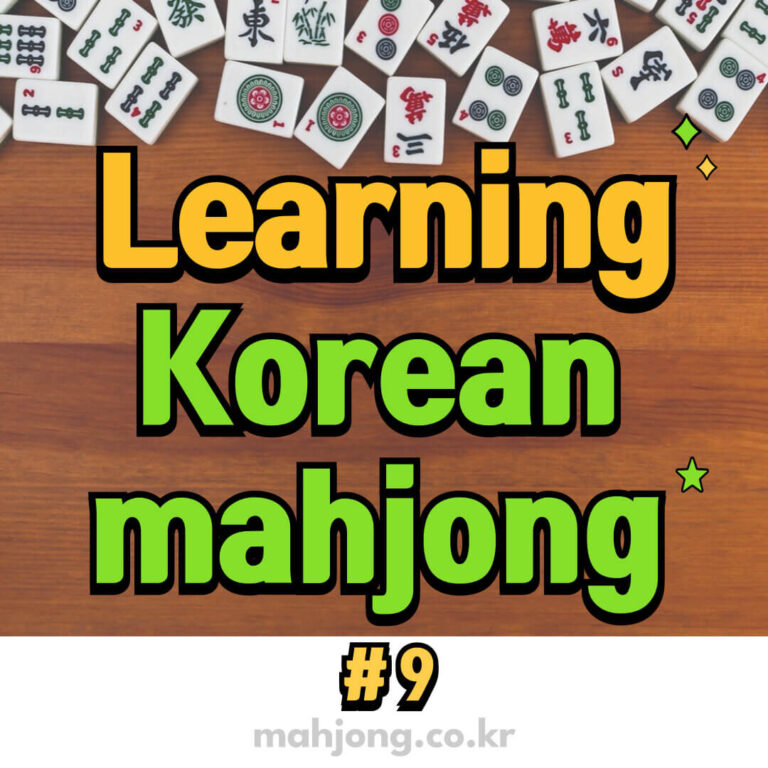Korean 2-Point Mahjong Ⅹ
– Standard Rules and Scoring for Beginners
Chapter 10. Korean Mahjong Hands (Yak) & Scoring
The object of mahjong is to complete a winning hand (yak). In Korean 2-Point Mahjong, there are 2 kind of scoring systems of winning hand : “Basic Point” and “Additional Point”. You need minimum of basic 2 points to declare the win (mahjong) for the game. The all basic points for each yak can be added together.
When calculating the minimum basic points of the yak, additional points such as “win on kong”, “uper”, etc. including Flower tiles are not counted. If a player completes a winning hand in the form of “1 pair + 4 sets” but the hand becomes a “chicken hand” that lacks a basic score, the player cannot win the game.
However, the additional point, also known as the bonus point, and each flower point is added to the final basic score. No matter how many bonus points you get, you cannot win the game with bonus point only.
The total number of winning hands in Korean 2-Point Mahjong is 38 (26 basic yak and 12 bonus yak). Each yak is scored from 1 to 24 points in order of difficulty.

10.1 Korean Mahjong Basic Hands (Yak) & Scoring
1 Point Hands
❶ Dragon Pung 삼원패(Samwonpae)
When a player has three or four dragon tiles of the same kind. A melded pung or kong is permitted. It also called “value honor” and “fanfai”.

❷ Prevalent Wind 장풍패(Jangpoongpae)
When a player has three or four wind tiles of the “prevalent wind” which corresponds to the round in progress. 1 round – east, 2 round – south. A melded pung or kong is permitted. It also called “value honor” and “fanfai”.
❸ Seat Wind 자풍패(Japoongpae)
When a player has three or four wind tiles of the “seat wind” which corresponds to the seat position in progress. East Seat – east winds, South Seat – south winds. A melded pung or kong is permitted. It also called “value honor” and “fanfai”.

❹ Concealed Hand 문전(門前, Munjeon)
A ready hand which is concealed, without any exposed sets such as pungs or kongs. A concealed kong is considered as a concealed hand.
❺ Win by Self-drawn on a Concealed Hand 문전 쯔모(Munjeon Zimo)
Going out (win) by self-draw on concealed hand. It is also known as “fully concealed hand”. But, there is no score at all for win by discarded tile from another player (win by discard).
❻ All Simples 단요(Danyo)
A hand entirely consists of simple tiles (2 to 8) without terminal or honor tiles. Melded pungs or kongs are permitted.

❼ All Sequences 평화(Pyeonghwa)
A hand consists of 1 eye and 4 sequences. You can only complete with discarded tile from another player while on concealed hand and with a two-sided sequence wait. The eye cannot contain any tiles of dragon, prevalent wind and seat wind.

2 Point Hands
❶ Double Winds 연풍패(Yeonpoongpae)
When a player has a “prevalent wind” and a “seat wind” at once. It is only possible one time per round; East Seat when 1 round-1st game, South Seat when 2 round-2nd game, West Seat when 3 round-3rd game, North Seat when 4 round-4th game. A melded pung or kong is permitted.
❷ Mixed One-Suit 혼일색(Honilsaek)
A hand combines honor tiles with any one suit tiles of two suits. Melded pungs or kongs are permitted.

❸ All Triplets 대대화(對對和, Daedaehwa)
A hand contains 4 sets of triplet or quadruplet. Melded pungs or kongs are permitted.

❹ Pure Straight 일기통관(Ilgitonggwan)
A hand consists of numbers 1 to 9 all in the same suit (forming three consecutive sequences of 1 to 9). Melded pungs or kongs are permitted.

4 Point Hands
❶ Seven Pairs 칠대자(七對子, Childaeja)
The hand consists of seven pairs. A concealed kong is considered as two pairs but a melded kong is not.

❷ Three Concealed Triplets 삼암각(Samamgak)
The hand contains three concealed triplets or quadruplets. The forth set is irrespective of whether it is concealed or melded.

5 Point Hand
❶ Anouncing a Ready Hand in first turn 부지 엎어(Buji Uper)
That anouncing a ready hand in first turn is called “buji uper” in korean. “Uper” means that lizhi(riitch) of Japanese lizhi mahjong, and “buji” means “the first turn”.
When 13 tiles (out of 14 tiles) of the hand tiles are already a “ready” in the very first draw, You may be able to declare the “buji Uper”, while discarding a useless tile. It is not a compulsory thing but a choice. Buji uper is also called “double lizhi”.
If a pung or a kong including a concealed kong occurs before the double lizhi declaration, double lizhi is never possible. Once you declare uper or buji uper, you can never exchange a tile in your hand tiles until you win.
6 Point Hand
❶ Little Three Dragons 소삼원(Sosamwon)
The hand that includes two triplets or quadruplets of dragon tile, and a pair of Dragons as the head. Melded pungs or kongs are permitted. Each triplet score of Dragons is not added.

8 Point Hands
❶ Pure One-Suit 청일색(Chungilsaek)
The hand entirely formed of one suit tiles. It is only possible on concealed hand.

❷ Big Three Dragons 대삼원(Daesamwon)
The hand contains three triplets or quadruplets of dragon tile. Melded pungs or kongs are permitted. Each triplet score of dragons is not added.

❸ Four Concealed Triplets 사암각(Saamgak)
The hand contains four concealed triplets or kongs. It is only possible on concealed hand. A concealed kong is considered as a concealed hand.

❹ All Terminals and Honours 혼노두(Honnodoo)
The hand entirely consists of terminal tiles (number 1 & 9) and honor tiles. Melded pungs or kongs are permitted.

❺ Little Four Winds 소사희(Sosahee)
The hand that includes three triplets or quadruplets of wind tile, and a pair of wind tile as the head. Melded pungs or kongs are permitted. Each triplet score of winds is not added.
12 Point Hands
❶ Big Four Winds 대사희(Daesahee)
The hand contains four triplets or quadruplets of wind tile. Melded pungs or kongs are permitted. Each triplet score of winds is not added.

❷ All Honors 자일색(Jaailsaek)
The hand entirely consists of honor tiles. Melded pungs or kongs are permitted.

16 Point Hands
❶ Blessing of Heaven 천화(Ceonhwa)
When the East Seat got 14 tiles as initial hand tiles, the hand tiles were already completed in the shape of “1 pair + 4 sets”. It is “blessing of heaven” and possible without a single basic point. But It is never possible after a concealed kong declaration.
❷ Blessing of Earth 지화(Jihwa)
The hand that South, West, and North Seat go out with self-draw at the very first turn. It is possible without a single basic point. But it is never possible after declaration of a pung or a kong including a concealed kong.
❸ Blessing of Man 인화(Inhwa)
The hand going out with the discarded tile from another player in the first turn. It is possible without a single basic point. But it is never possible after declaration of a pung or a kong including a concealed kong.
24 Point Hand
❶ Nine Gates 구련보등(Gooryeonbodeung)
If you are holding the ready hand of 111 2 3 4 5 6 7 8 999 tiles of the same suit (which is called nine-sided wait), you can win with any tile of the same suit. The hand is “nine gates”. Nine gates is only possible on concealed hand.

If you discard a suit tile before making a ready hand and you make the ready hand of “nine gates” with the same kind of the suit tile you discarded, you will not win on another player’s discard tile, but you will be able to win on self-draw.
10.2 Korean Mahjong Bonus Hands (Yak) & Scoring
1 Point Hands
❶ Anouncing a Ready Hand(Lizhi) 엎어(Uper)
If you make a ready hand on a concealed hand, You may be able to declare “uper!” clearly while discarding a useless tile. When declaring uper, you should place the discard tile horizontally, not vertically on the floor.
Once you declare uper, you can never exchange a tile in your hand tiles until you win. You must only declare uper when you can secure at least basic 2 score and win the game even if you bring another player’s discard tile.
❷ Korean style Dora 겐쇼(Genshow)
The winner also receives bonus points for the total number of the winning tile.

In this hand, blue dragon is the winning tile, so the genshow bonus is 2 points.

In this hand, 2 of wans is the winning tile, so genshow bonus is 3 points.
❸ Flower Tiles 꽃패(Kkotpae)
Each flower tile you get is worth 1 bonus point. When draws a flower tile from the wall, a player should place it to the side around his or her hand tile and must draw a replacement tile from the backwall. If the player wins with this replacement tile on concealed hand, then “fully concealed” (basic 1 point) yak is also added to the winning hand.
2 Point Hands
❶ Open Lizhi 불러(Buller)
“Buller” is to tell other players exactly what tiles you can win the game with. The player can declare “Buller!” (“Open Lizhi” in Japanese) at the same time declaring “Uper” or after declaring uper. The player can get extra bonus point by declaring the buller and going out. The buller is considered as a concealed hand.
5 Point Hands
❶ Robbing the Kong 창깡(Changkong)
When a player declaims a “big exposed kong” or develops a “melded pung” into a “small exposed kong” while declaring “Kong!”, just then, another player can win with the tile of the exposed kong. This winning hand is called “robbing the kong”.
Robbing the kong counts as win by discard and is also called “mahjong on a discard”, and “ron” in Japanese. Robbing the kong cannot apply to rob a concealed kong.

❷ Win on Kong 깡올라(Kongolla)
The hand wins with a supplement tile after declaring a kong. “Win on kong” counts as a self-draw. It is also called “going out with supplement tile”.
If a replacement tile for flower tile becomes a set of kong (a small exposed kong or concealed kong), the player may declare kong and draw a supplement tile. If the supplement tile is the very last tile in the wall, the points for “win on kong” and “last tile draw” will be added.
❸ Last Tile Draw 라스트 올라(Last Olla)
The hand that wins with self-draw by the last tile on the wall. “Last tile draw” also applies to the supplement tile for a kong and flower tile.
Last tile draw means feeling the moon reflected at the bottom of the sea with your hands in Chinese. It is named “seabed” tile in Korea and Japan.
❹ Last Tile Claim 라스트 쏘아(Last Ssoa)
The hand that wins with last discard tile by another player in the game. “Last tile claim” means lifting the moon at the bottom of the sea in Chinese. It is named “riverbed” tile in Korea and Japan.
8 Point Hands
❶ All Flowers 화만관(Whamangwan)
The hand that a player collects all four flower tiles.
❷ Last Tile Draw of No.1 of pins 라스트 1통 올라(Last 1-Tong Olla)
The hand that wins with self-draw of the very last tile that is “No.1 of pins” by chance. It is aptional.
❹ Win on Kong of No.5 of pins 5통 깡올라(5-Tong Kongolla)
The hand that wins with a supplement tile that is “No.5 of pins” by chance. It is aptional.
❸ Last Tile Claim of No.1 of pins 라스트 1통 쏘아(Last 1-Tong Ssoa)
The hand that wins with another player’s very last discard tile that is ‘No.1 of pins’ by chance. It is aptional.





